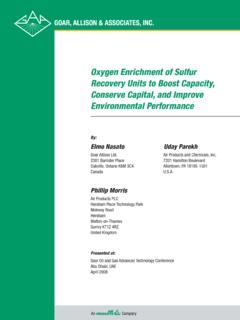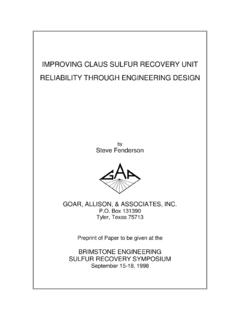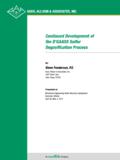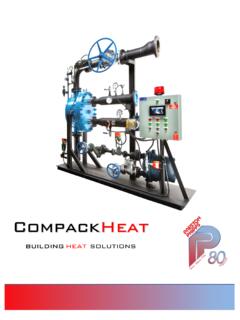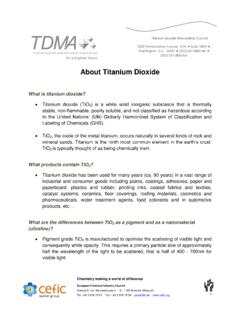Transcription of Sulfur Degasification— The D’GAASS TM Process
1 Sulfur degasification The D GAASSTM ProcessBy:Elmo Nasato, P. Eng. and Travis A. Allison, , Allison & Associates, Sybil LaneTyler, Texas at: Sulfur Recovery SymposiumBrimstone Engineering Services, Inc. and Brimstone Instrumentation 23 26, 1997 2 Abstract Goar, Allison & Associates, Inc. (GAA) has developed and received a patent for the D GAASS Sulfur degasification Process . The Process is a simple, low capital cost and low operating cost degassing Process that achieves less than 10 ppmw H2S equivalent in liquid Sulfur . The unique design features of the D GAASS Process allow for easy retrofitting to an existing plant or incorporation into grass root plants.
2 The small flow of pressurized gas waste stream can easily be recycled to the SRU main burner, thus eliminating the degassing Process as an emission source. The first D GAASS unit was retrofitted September 1996 to the 160 LTPD Sulconam Facility located in montreal , Canada. This 160 LTPD D GAASS Unit has been tested at various combinations of Process parameters with all analytical work performed by Alberta Sulfur Research Ltd. (ASRL) using the state-of-the-art Fourier Transform infrared (FTIR) analytical procedure. Test results have verified that the D GAASS Process is capable of degassing liquid Sulfur to below 10 ppmw of combined H2S and H2Sx. Introduction Sulfur degasification is a Process that removes dissolved H2S and H2Sx vapor from produced liquid Sulfur .
3 Undegassed Sulfur presents odor and potential toxic hazardous conditions in the storage, loading and transport of liquid Sulfur . Also, up to 80% of H2S/H2Sx present in the liquid can be retained on solidification. The gradual release of H2S gas from Sulfur in the solid form presents odor problems. Also, the gas gives voids and surface imperfections which weakens the solid, and increases dusting in handling. Tests have shown that H2S concentrations of greater than 20 ppmw in liquid Sulfur can result in closed vapor spaces with H2S concentrations greater than the lower explosion limit of Obviously, the explosivity concern is also coupled with the H2S toxicity issue. Toxic levels of H2S can build up in closed vapor spaces of Sulfur pits and transport containers.
4 Also, high levels of H2S may accumulate near Sulfur pit and Sulfur loading areas. degasification is clearly the best method of preventing H2S release from liquid or solid Sulfur , and the associated problems with odor, explosivity and toxicity. The patented D GAASS Process reduces combined H2S/H2Sx to 10 ppmw in Sulfur product in a simple, low capital and operating cost method without catalyst addition. The Process operates at elevated pressure, thus allowing the use of a small, low residence time vessel that is easily retrofitted external to Sulfur pits. The elevated operating pressure easily allows for recycling of the overhead vapor stream back to the SRU main burner, thus eliminating Sulfur degassing as an emission source. 3 The first commercial D GAASS Unit was commissioned in September, 1996 at Sulconam s montreal Facility.
5 The D GAASS Process was retrofitted to the existing 160 LTPD SRU at Sulconam. The design and operating results of the D GAASS Unit at Sulconam are presented in this paper. Existing Technologies The existing major Sulfur degassing technologies use a combination of mechanical, catalytic and/or oxidation techniques for the removal of H2S/H2Sx from liquid Sulfur (2). Several commercial technologies are capable of achieving the generally accepted residual H2S standard of 10 ppmw. The relative capital cost of the existing technologies is approximately equal (3). While the existing technologies are capable of achieving the 10 ppmw specification, some of the limitations of the existing technologies include: 1) High capital cost 2) Difficult to retrofit to existing SRU 3) High operating cost 4) Long residence time, thus large footprint 5) Catalyst requirement with possible negative impact on (a) Sulfur quality (b) salt formation resulting in equipment plugging 6) Additional SO2 emissions because degasification waste stream (containing H2S, SO2 and/or S) is fed to the incinerator.
6 The D GAASS Process addresses all these limitations in a simple, low capital and operating cost, zero emission technology that degasses liquid Sulfur to less than 10 ppmw combined H2S/H2Sx. New Approach The D GAASS Process The D GAASS Process exploits the favorable thermodynamic equilibrium for the oxidation of H2S, while addressing the kinetic limitations of the same reaction. Liquid Sulfur produced by the Claus Process typically contains 200-250 ppmw H2S/H2Sx. A major part of the H2S is bound to long poly- Sulfur molecules, and is called The H2Sx exists in equilibrium with H2S dissolved in Sulfur . Thus, removal of H2S from the liquid results in decomposition of H2Sx to H2S, allowing ultimate total H2S/H2Sx degasification to below the targeted 10 ppmw total.
7 Kinetic experiments have indicated that the rate equation, and hence, the order of the reaction is first order with respect to H2S concentration. The overall partial oxidation of H2S and H2Sx to Sulfur is given by the elementary reactions: H2S + O2 H2O + S (1) H2Sx + O2 H2O + Sx (2) 4 The D GAASS Process is designed to operate at elevated pressures to address the kinetic limitations, resulting in a small contactor that achieves the target 10 ppmw H2S/H2Sx. D GAASS Design Parameters The key to the D GAASS Process is the elevated operating pressure with the fixed vessel internals.
8 degasification is carried out in a pressurized vertical vessel, which contacts the undegassed Sulfur with pressurized Process air (instrument or clean utility air). The undegassed Sulfur is pumped to the vessel and intimately contacted with air across special fixed vessel internals. Operating pressures are typically in excess of 60 psig. The elevated pressure improves the kinetics of the oxidation Process . Due to the elevated pressure, no catalyst addition is required; the elevated pressure in combination with the fixed internals is sufficient to degas the liquid Sulfur to below 10 ppmw H2S/H2Sx. The fixed vessel internals are sized based on GAA tower modeling criteria. Commercial data are not available for liquid Sulfur /air systems operating at elevated pressures.
9 Effective vapor-liquid contacting with sufficient reaction residence time is necessary for effective degassing. Also, a properly sized wire mesh mist eliminator is utilized to minimize potential Sulfur liquid entrainment in the overhead vapor stream. The D GAASS Process Advantages As a result of the improved kinetics due to the elevated pressure with the special fixed internals, the D GAASS Process has several economic and operating advantages. a. Size and Capital Cost Operation at elevated pressure reduces the size and reaction time requirements. The commercial 160 LTPD unit is an 18 vessel. With a tower height of 30 , or less, the D GAASS contactor requires a small footprint and is easy to retrofit.
10 The carbon steel construction makes this small vessel relatively inexpensive; the fixed internals cost in the range of 20-30% of the vessel cost. Since the Process is external of the Sulfur pit, downtime for installation, if any, is minimal. The overall size is small and the equipment cost is low. b. Low Operating Cost For continuous operation, the improved kinetics results in much lower air requirements than other commercial units. Typical annual operating costs for the Sulfur pumping and Process air requirements are given below. 5 SRU Capacity LTPD Annual Operating Cost (1) ($) 100 2,000 1000 20,000 Note 1.
